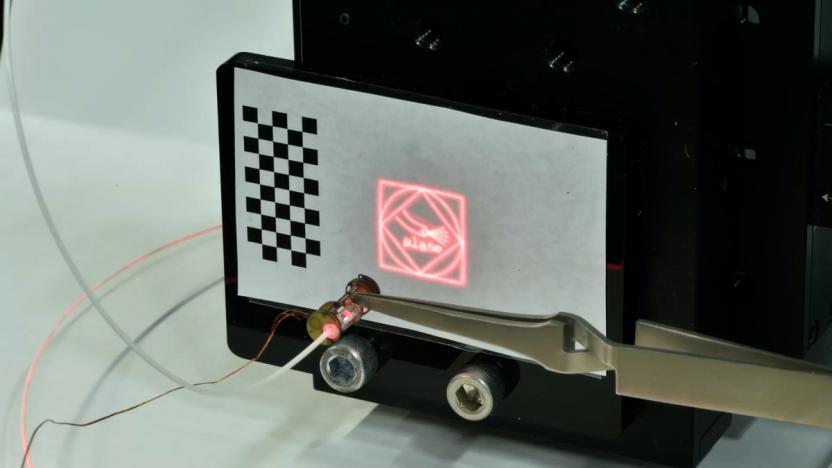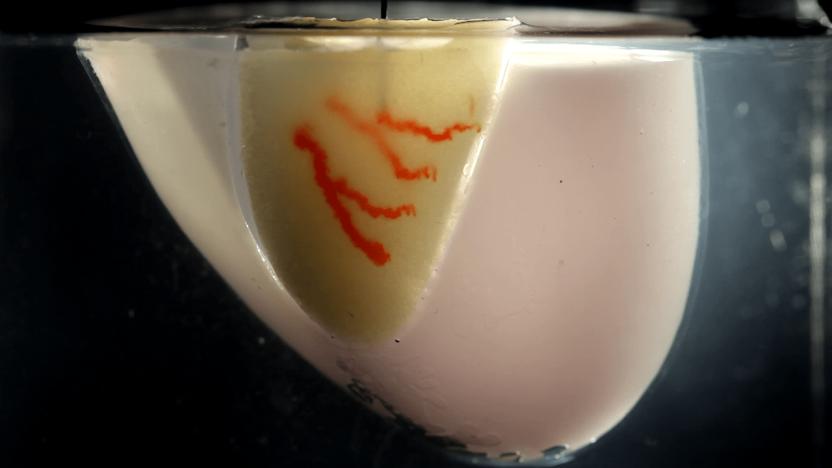Wyss Institute
Latest

Scientists 3D-print a functional piece of a heart
Researchers have 3D-printed heart filaments that could eventually repair damaged hearts.

Laser microrobot makes minimally invasive surgery more precise
Minimally invasive surgery techniques have gone far over the past few decades, but they still have limitations that scientists are working to overcome. Laser micro surgery, for instance, leaves minimal peripheral tissue damage, but it can only be used on parts of the body within the laser’s line of sight. Meanwhile, surgery using flexible robotics can access hard-to-reach areas, but they can damage surrounding tissue.

Harvard and Sony built a tiny surgery robot inspired by origami
The mini-RCM is about the size of a tennis ball and weighs the same as a penny.

This machine keeps transplant livers alive for a week
With current technology, a human liver donated for transplant can only be kept alive for 24 hours, and often, if the liver is damaged or diseased, it cannot be considered for transplant. That could soon change. Liver4Life has developed a liver perfusion machine that can preserve injured human livers for one week and can even repair damage.

Harvard scientists have found a better way to 3D print organs
Scientists have experimented with growing organs in labs for years, but we're still years away from the technology being ready. Lab-grown organs are often too small for human use and lack an efficient mechanism for delivering oxygen. A group of scientists at Harvard's Wyss Institute have now developed a solution that will 3D print blood vessels on living tissues. Their paper, published today in Science Advances, explains how a new technique called the SWIFT method (Sacrificial Writing Into Functional Tissue), will enable the creation of larger, more effective organs.

Harvard's noodly robot fingers are great at grabbing jellyfish
Robots can be a bit heavy-handed. Their forceful grip might not be a problem when they're moving boxes in a warehouse, but they can damage fragile marine creatures like jellyfish. Researchers may have a solution. They've created a robotic hand with a squishy grabber and a gentle grip that uses "fettuccini-like silicone fingers" to catch and release fragile, gelatinous jellyfish.

Harvard stores 704TB in a gram of DNA, may have us shopping for organically-grown storage (video)
Early research has had DNA making circuits and little factories. We haven't really seen DNA used as a storage medium, however, and it's evident we've been missing out. A Harvard team led by George Church, Sriram Kosuri and Yuan Gao can stuff 96 bits into a DNA strand by treating each base (A, C, G, T) as though it's a binary value. The genetic sequence is then synthesized by a microfluidic chip that matches up that sequence with its position in a relevant data set, even when all the DNA strands are out of order. The technique doesn't sound like much on its own, but the microscopic size amounts to a gigantic amount of information at a scale we can see: about 704TB of data fits into a cubic millimeter, or more than you'd get out of a few hundred hard drives. Caveats? The processing time is currently too slow for time-sensitive content, and cells with living DNA would destroy the strands too quickly to make them viable for anything more than just transfers. All the same, such density and a lifespan of eons could have us turning to DNA storage not just for personal backups, but for backing up humanity's collective knowledge. We're less ambitious -- we'd most like to know if we'll be buying organic hard drives alongside the fair trade coffee and locally-sourced fruit.

Alt-week 7.28.12: social mathematics, Pluto's moons and humans-on-a-chip
Alt-week peels back the covers on some of the more curious sci-tech stories from the last seven days. It's a beautiful world we live in. And, while the sweet and romantic part is debatable, strange and fantastic is not. Our universe is one populated by non-planetary celestial bodies with their own non-planetary satellites, high school social hierarchies based on predictable mathematical formulas and military-funded "gut-on-a-chips." It's a weird place filled with weird stories, and we just can't get enough of it. So, what has the last seven days brought us from the fringes of science and tech? Keep reading after the break to find out. This is alt-week.

Self-assembling nanodevices could advance medicine one tiny leap at a time
Seems like Harvard wasn't content with making robotic bees, and has taken its quest for miniaturization right down to the nanoscale level. One nanometer-wide, single-stranded DNA molecules are the topic of the university's latest research, which sets out a way they can be used to create "3D prestressed tensegrity structures." Should these theoretical scribblings ever pan out in the real world, we could see the resulting self-assembled nanodevices facilitating drug delivery targeted directly at the diseased cells, and even the reprogramming of human stem cells. Infusing a nanodevice with the relevant DNA data passes instructions on to your stem cells, which consequently turn into, for example, new bone tissue or neurons to augment your fleshy CPU. Yes, we're kinda freaked out, but what's cooler than being able to say you're going to the doctor for a shot of nanotransformers?





